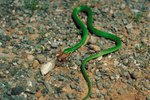Finding a snake hole in your yard can be unsettling, as it seemingly indicates the presence of one or more snakes near your home. Fortunately, there are only five types of poisonous snakes in the United States: rattlesnakes, copperheads, cottonmouths, coral snakes and sea snakes. In fact, most snake holes were not even made by snakes, but are chipmunk or other rodent homes that were taken over by snakes. While the majority of snakes you will find in your yard are not poisonous, it is always the best policy to use care when disrupting a wild animal's habitat in any way.
Leave It Alone
If you come across a hole in your garden or yard that you think might be a snake hole, the easiest course of action is to simply leave it alone. There are only four types of venomous snakes that live on land in the United States, and your snake is far more likely to be a harmless garter snake. Snakes are a natural balance in the ecosystem: They eat insects, frogs, and pests like mice and rats. Most snakes are also very shy and will quickly slither away when disturbed, leaving you in peace. Snakes are a positive addition to any yard, and, unless they bother a pet or you have an intense fear of them, leaving them alone can be the best policy.
Cover It
Snakes live in holes because they like cool, dark, private places. They may be attracted to holes everywhere from your yard to old stumps to crevices in buildings. If you have a snake infestation that is bothering you, blocking off these holes and disturbing the snakes' habitats is a great way to discourage them from coming back. Covering holes with wire fencing, boards or burlap are all options. However, use care not to pile too much on top of the hole, as you might just end up creating a new place for the snakes to burrow. Use extreme caution when interfering with snake holes: Be prepared for a run-in with a snake.
Call an Exterminator
If you are very squeamish of snakes, and both their presence and getting rid of them is unpleasant for you, a wildlife control or pest management exterminator can come to your home and assess your options for you, offering a number of solutions. Glue boards are a messy but effective means for capturing snakes. Trapping is also effective, as can be the extremely expensive snake fence option. Unfortunately, no repellent currently exists for eradicating snakes. If the snakes you have seen are quite large, or you are unsure of their type and are concerned they might be venomous, calling animal control is the wisest option.
What Not to Do
Always be careful when interfering with snakes. While most snakes are harmless, don't try to pick one up barehanded, as it may bite; gloves and sticks are recommended for transporting snakes. Before exterminating snakes, check with state and local laws; some states have laws against shooting or clubbing snakes. Don't try to use a fumigant against snakes; none are currently legal or approved in the United States. Use extreme caution when interacting with any wild animal.
References
- Internet Center for Wildlife Damage Management: Control of Nonpoisonous and Nonvenomous Snakes
- Rutherford County, Tennessee: Controlling Snake Problems Around Homes
- Louisiana Department of Wildlife and Fisheries: Frequently Asked Questions
- University of Massachusetts Amherst: Snakes of Massachusetts: The Facts
- New York State Department of Environmental Conservation: Nuisance Wildlife Control Operators: Snakes
Photo Credits
-
Hemera Technologies/PhotoObjects.net/Getty Images
Writer Bio
Based in northern Virginia, Rebecca Rogge has been writing since 2005. She holds a bachelor's degree in journalism from Patrick Henry College and has experience in teaching, cleaning and home decor. Her articles reflect expertise in legal topics and a focus on education and home management.





